3677) Aztec Calendar, Mexico: A $100 1 Kilo Silver BU Coin w/Box & COA: Date of Coin issue: 2024:
The popular Silver Aztec Calendar series is back with a new release. This 1 kilo silver coin features a beautiful design of the Aztec calendar sun stone in impressive detail.
Coin Highlights:
- Contains 1 kilo (32.15 oz) of .999 fine silver.
- Limited mintage of 500 coins.
- Includes a certificate of authenticity with a unique serial number, a laser-etched timber display case and a magnifying glass.

Guaranteed by Banco de México.
Mexico 1 Kilo Silver Aztec Calendar
A 1 kilo silver coin was first released in 2007, displaying a beautiful design of the Aztec calendar. The Aztec calendar design originates from the calendar system used by the Aztecs, which consists of a 365-day calendar cycle and a 260-day ritual cycle. These two cycles combine to form a 52-year century. The 365-day calendar cycle, known as “xiuhpohualli” or the “counting of the years,” is based on the solar cycle. The calendar is divided into 18 groups of 20 days each.
The 260-day ritual cycle, known as “tonalpohualli” or the “counting of the days,” is most likely based on astronomy.
This calendar cycle was broken into units of 20 days and ran simultaneously with a group of 13 numbered days. The Aztec calendar stone displays this calendar system and the face of the Aztec sun god, Tonatiuh, in the centre of the stone surrounded by four square panels honouring previous ages of the world.
The Mexican Mint:
La Casa de Moneda de Mexico (Mexican Mint), which is the national mint of Mexico and the oldest mint in North America established in 1535, produces Libertads as well as the Aztec calendar coins. The Bank of Mexico is the Mexican Mint’s largest client, producing circulating coinage and currency for the country as well as precious metal coins. The mint is in Mexico City.
PRODUCT SPECIFICATIONS:
Year: 2024
Grade: Brilliant Unc
Grade Service:None
Denomination:100 Dollars
Mint Mark: Mo – Mexico City
Metal Content: 32.15 troy oz
Purity: .999
Thickness:11.5 mm
Diameter:110 mm
The ancient civilisations of Mesoamerica developed complex calendar systems based on over-lapping cycles of time. The Aztec calendar is a symbolic portrayal of the four disasters that led to the demise of four prior Universes in Aztec cosmology. It contains an hieroglyphic and pictographic layout of how the Aztecs measured time.
This circular calendar stone measuring about 12 feet (or 3.7 metres) in diameter and weighing about 25 metric tons and 4 feet in thickness, was uncovered in Mexico City in 1790 and is presently on display in the National Museum of Anthropology in Mexico City's Chapultepec Park. It was during the reign of the 6th Aztec monarch in 1479, that this stone was carved and dedicated to the principal Aztec deity - The Sun.
Historically, the Aztec name for this monolithic time-keeper is "Cuauhxicalli" (or "Eagle Bowl"), but it is universally known as the Aztec calendar or the Sun Stone.
The face of the Aztec Sun God "Toniatiuh" appears in the centre of the stone, surrounded by four square panels honouring the deity that represent the four previous ages of the world.
The Calendar of the Aztecs was derived from earlier calendars in the Valley of Mexico and was basically similar to that of the Mayan civilisation.
The Aztecs based the beginning of the year on the appearance of the Pleiades asterism (i.e. when it rises from the East before the Sun's morning light becomes too bright. They called this star cluster by the name of "Tianquiztli"(meaning "market place").
However, over time, due to the precession of the Earth's axis, this system fell out of favour for a more constant reference point such as a solstice or an equinox. The common practice soon saw it as being celebrated in proximity with the Spring equinox.
"Toniatiuh" (the Sun's face) in the centre:


The first ring from the Centre:
The first ring depicts four squares in which are seen four "Olin" (which represent the Earthquake Epoch or Sun). The four epochs represented inside the square portions of this symbol correspond to the four previous epochs also called the "Suns" (A, B, C, & D).
The second ring from the Centre:
The second ring from the Centre is composed of 20 named days contained in a month. It is also used for naming the years - each of which starts on one of four of these 20 days (1 to 20).
The third ring from the Centre:
The third ring features the Sun's (Toniahtiuh's)) rays, Chalchihuite Ornaments and Splashed blood symbols (I).
The fourth ring or Outer ring from the Centre:
The fourth ring features the Dedication plate, herbs with Buds, white scrolls, a Flame symbol and Xiucoatl's Tail (a mythological "turquoise serpent, regarded as the spirit form of Xiutecuhtli, the Aztec fire deity) - E, J, K & L.
The "Tonalpohualli" (or the "day count") consists of 260 days and was the sacred almanac of the Aztecs/Mexicans. This ritual calendar was registered in the "Tonalamatl" (Book of days), a green-fold bark paper or deer-skin codex from which a priest (clled "Tonalpouque" cast horoscopes and predicted favourable and unfavourable days. It was called the sacred calendar because its main purpose is that of a divinatory tool. It divides the days and rituals between gods. For the Aztec belief this was an important aspect, for they believed that without it, the world would soon come to an end.
According to Aztec cosmology, the universe is in a delicate state of equilibrium, with opposing divine forces competing for power. This equilibrium is in constant danger of being disrupted by shifting powers of the Gods, and the elemental forces which influence our lives with no God emerging as a victor.
The notion that everything ultimately consists of two opposing forces is essential to the Aztec world/Universe view. The world is always on the brink o going into a spiritual "war" - a "War of the Gods" competing for supreme power. To prevent this from happening, the gods have been given their own space, their own time, their own social groups, et al. The Tonalpohualli tells us how time is divided among the gods.
The system of the "Tonalpohualli":
Each day is signified by a combination of a number from 1 to 13 and one of the 20 day signs. Each day is dedicated to a god or elemental force - the provider of "Tonalli" ("Shadow Soul") life energy for the 20 day signs. The nature of the day is also influenced by a force related to its number. This provides the "Teyollia" ("Spirit Soul") for the given day.
With each new day, both the number and day sign would be incremented - 1 (Crocodile) is followed by 2 (Wind), 3 (House) and so on upto 13 (Reed) after which the cycle of numbers would restart (though the 20 day cycle has not yet been exhausted),then Jaguar becomes day 1, Eagle becomes day 2 and so on. It takes a full 260 days (13 x 20 =260) for the two cycles of twenty day signs and 13 numbers) to realign and repeat the sequence back from 1 (Crocodile).
The day signs:
The set of day signs used in Central Mexico is identical to that used by Mixtecs (an indigenous Mesoamerican people of Mexico who inhabited the region knows as "La Mixteca" of Oaxaca and Pueblo and the state of Guerrero's Region Montanas and Region Chica, which covers parts of the Mexican states of Oaxaca, Guerrero and Puebla) and to a lesser degree similar to those of other Mesoamerican calendars.
Each day sign also bears an association with one of the four principal directions. The directions follow an E, North, West and South sequence. The most popular day sign illustrations are taken from the "Codex Magliabechiano" (an Aztec pictorial codex created during the mid-16th Century, in the early Spanish colonial period. It is representative of a set of codices known collectively as the "Magliabechiano Group", the other two included in the Group being "Codex Tudela" and "Codex Ixtlilxochitl".
Basically the 20 signs and directions are as under:
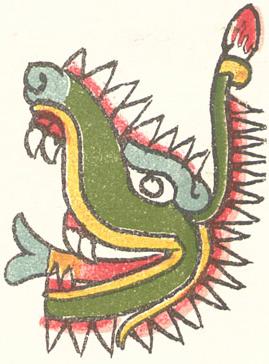
The Nahuatl name of this Aztec day sign is "Cipactli" (it signifies a Crocodile, Alligator, Caiman, Crocodilian Monster & Dragon and its direction is East
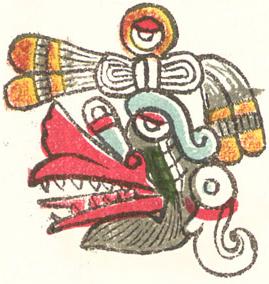
The Nahuatl name of this Aztec day sign is "Ehecatl" ( Wind) and its direction is North

The Nahuatl name of this Aztec day sign is "Calli" (House) and its direction is West

The Nahuatl name of this Aztec day sign is "Cuetzpalin" (Lizard) and its direction is South
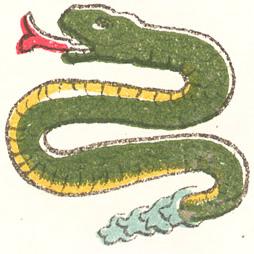


 The Nahuatl name of this Aztec day sign is "Tochtli" (Rabbit) and its direction is South
The Nahuatl name of this Aztec day sign is "Tochtli" (Rabbit) and its direction is South



 The Nahuatl name of this Aztec day sign is "Acatl" (Reed) and its direction is East
The Nahuatl name of this Aztec day sign is "Acatl" (Reed) and its direction is East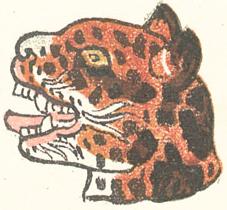

 The Nahuatl name of this Aztec day sign is "Cozcacuauhtli" (Vulture) and its direction is South
The Nahuatl name of this Aztec day sign is "Cozcacuauhtli" (Vulture) and its direction is South
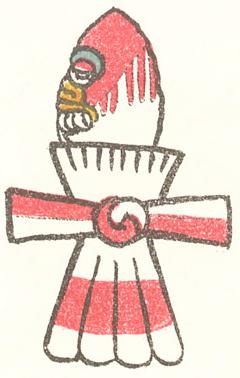 The Nahuatl name of this Aztec day sign is "Tecpati"(Flint, Flint knife) and its direction is North
The Nahuatl name of this Aztec day sign is "Tecpati"(Flint, Flint knife) and its direction is North The Nahuatl name of this Aztec day sign is "Quiyahuitl" (Rain) and its direction is West
The Nahuatl name of this Aztec day sign is "Quiyahuitl" (Rain) and its direction is West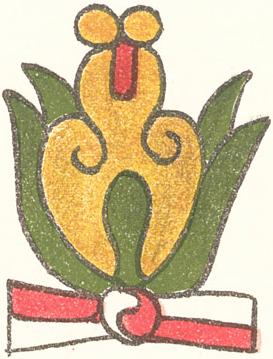
Trecenas:
The 260 days of the sacred calendar were grouped into 20 periods of 13 days each. Each 13 day period is the equivalent of "weeks" (or "Trecenas") using a Spanish term derived from "trece" or "thirteen". The original Nahuatl term is lost in the obscurity of time.
Each "trecena" is in turn named according to the calendar date of the first day of the 13 days in that "trecena". Each of the 20 "trecenas" in the 260 is presided over by its own tutelary deity/lord:
Trecena - Deity
1 Crocodile Ometeotl ("Om" translates as
"two" or "dual" in
Nahuatl and "Teotl"
as "God". The term
refers to the Aztec
deities "Ometecuhtli"
(or "Tonacatecuhtli")
and "Omecihuatl" (or
"Tonacacihuatl").
1 Jaguar Quetzalcoatl (A deity in
Mesoamerican culture whose name in Nahuatl
means "feathered serpent"
or "Quetzal feathered serpent").
1 Deer Tepeyollotl (The god of earth-
quakes, echoes and
jaguars)
1 Flower Huehuecoyotl (He is the auspicious god of music, dance,
mischief and song of
Pre-Columbian Mexico)
1 Reed Chalchiuhtlicue (An Aztec deity of water, rivers, seas,
streams, storms and
baptism and patroness
of child-birth.
1 Death Tonatiuh (He is the Sun God and the leader of
Tollan - heaven. Also
known as the fifth
sun, because the Aztecs
believed that he was
the sun that took
over when the fourth
sun was expelled from the sky).
1 Rain Tlaloc (A member of the pantheon of gods in
Aztec religion. As sup-
reme God of rain, he is
also a god of earthly
fertility and of water. He is worshipped as a beneficent giver of life and sustenance, but feared for his ability to send thunder, hail and lightning.
1 Grass Mayahuel (A female deity associated
with the Maguey plant)
1 Snake Xiuhtecuhtli ("Lord of the Fire", day and heat. Also lord of the volcanoes, personification of life after death, warmth, and food during famine. Also alled "Cuezaltzin" and "Ixcozauhqui").
1 Flint Mictlantecutli ( A god of the dead and the King of Mictlan (Chicunauhmictlan) , the lowest and Northern- most section of the Underworld).
1 Monkey Patecatl (God of healing and fertility and discoverer of peyote and the "Lord of the root of pulque").
1 Lizard Itztlacoliuhqui (God of Frost and represents matter in its lifeless state).
1 Quake Tlazolteotl (A deity of vice, purification, steam baths, lust, midwives, filth and a patroness of adulterers. She is also known by other names - Tlahelcuani, Tlahelcuani and Ixcuinan).
1 Dog Xipe Toteuc (The cycle of life deity, god of agriculture, vegetation, the East, disease, spring, goldsmiths, silversmiths, liberation and the seasons. Also known by the name of Tlatlauhca).
1 House Itzpapaloti (A skeletal warrior goddess who ruled over the paradise world of Tamoanchan, victims of infant mortality and the place where humans were created).
1 Vulture Xoloti (A god with associations to both lightning and death, associated with sunset. He guards the Sun as it travels at night).
1 Water Chalchiuhtotolin (The god of disease and plague. He is the jewelled fowl and the symbol of sorcery. He can tempt humans into self-destruction, but when he takes his turkey form, he can also cleanse them).
1 Wind Chantico (the female deity reigning over fires in the family hearth).
1 Eagle Xochiquetzal (Also called "Ichpochtli" (meaning "maiden") is a goddess associated with fertility, beauty, female sexual power and is a protector of young mothers and a patroness of pregnancy, child-birth and the crafts practiced by women like weaving and embroidery.
1 Rabbit Xiuhtecuhtli (the God of Fire, day
and heat).
The "Teyollia" (Nature of the Day):
The nature of the day is also influenced by a force related to its number. This provides the "Teyollia (Spirit Soul) for the given day. The numerals with their names in Nahuatl and their related spirits are:
No. Natuatl God
1 Ce Xiuhtecuhtli
2 Ome Tlaltecuhtli
3 Yei Chalchihuitlicue
4 Nahui Tonatiuh
5 Mahcuilli Tlazolteotl
6 Chicuacen Mictlantecuhtli
7 Chicome Centeotl
8 Chicuei Tlaloc
9 Chicunahul Quetzalcoatl
10 Mahtlactli-once Tezcatlipoca
11 Mahlactli-omome Tlahuizcalpantecuhtli
12 Mahalactli-omei Citlalicue
"Xiuhpohualli" ( or the "Aztec Solar Year"):
"Xiuhpohualli is the Aztec Solar year ("Xihuitl") count ("Pohualli").
Each year consists of 360 named days and 5 nameless days ("Nemoteml").
These "extra days" are believed to be unlucky. The year was broken into 18 periods of 20 days each. The Nahuatl word for moon is "Metztli", but the names for these periods is now lost.
The Spanish term for the 20-day period of the Aztec Calendar is "Veintena".
Each 20-day period started on "Cipactli (Crocodile) for which a festival was held. The 18 "Veintena" are given in detail hereunder, based on the records/observations of Deigo Duran and Bernardino de Sahagun. Two differing calendar dates are shown here based on their observations:
Duran time: Mar 1 - Mar 20; Sahagun time: Feb 2 - Feb 21; Fiesta names: "Atlcahualo", "Cuahitlehua"; symbol above signifying ceasing of water, Rising trees.

Teotleco: The twelfth month of the Aztec calendar. Also the festival in Aztec Religion called theFestival of all Gods where all Gods are worshipped.
Xiuhmolpilli sculpture bearing the symbolic markings which show the completion of the 52 year cycle
Every 52 years, the Tonalpohualli and the Xiuhpohualli calendars align themselves. This marks what is known as a "Mesoamerican century". Every one of these centuries is marked by Xiuhmolpilli or the "Binding up of the years" or the "New Fire Ceremony".
This was a festival that lasted 12 days and included fasting as a symbol of penitence.
At the beginning of this festival all the lights in the city were extinguished - people let their hearth fires go out. Then on midnight of the 12th day of the festival, a prisoner was taken to the priest.
The priest would watch in the night sky for the "Star of Fire" to reach its zenith, which is when, the priest would remove the heart of the man and replace it with a piece of wood, that was laid out on a piece of turquoise. Then, the priest would start the new fire that would once again light the city.
An example of how the Aztec Calendar operates:
Today is 10.02.2019:
In the Tonalpohualli , the sacred Aztec Calendar, 10.02.2019 is detailed as follows:
The Tonali (day) is 10-Ehecatl (wind), Trecena (13-day period) is 1- Acatl (reed), thXihuitl (Solar Year is 7-Acatl (reed), Yoaltecuhtli (Lord of the Night) , Xiuhpohulli (365 day calendar) is 9- Etzcualiztli (VI).
The significance of this day:
Day Ehecatl (wind) is governed by Quetzalcoatl as its provider of Tonalli (Shadow Soul) life energy. Ehecatl is a bad day for working with others. Its influences are inconsistent and vain. A good day to root out bad habits.
The 13 day period (trecena) that starts with day 1- Acetl (Reed) is ruled by Chalchihuitlicue, goddess of lakes, rivers and seas, goddess of horizontal waters.
This is an image of a round/coin titled "CALENDARIO AZTECO", "MEXICO". It shows the Aztec Calendar Stone in its entirety. This round has been brought for me by Ajit George, during his recent trip to Mexico.
This is an image of a 10 Peso Coin ("Deiz Peso") which shows the centre of the Calendar Stone together , the "Tonatiuh" in the centre, along with the first ring showing four previous Suns. This coin has also been brought for my collection by Ajit George.
Links:
2) Some ancient coins depicting Greek mythology & history
13) Ancient Greek Theatres, Greece: Hellenic Post has brought out a set of five stamps featuring the Ancient Theatres of Dodona, Nocopolis, Kassope, Amvrakia and Gitana (all in Epirus): Stamp issue date: 08.04.2020
14) "MYRTIS", Greece: A 5 Euro Silver Coin dedicated to an 11 year old girl who was a victim of the PLague of Athens (430-426 BC) issued by the Bank of Greece: Coin issue date: 25.02.2020
For some other interesting posts on Currencies of the Caribbean Sea and the Atlantic Ocean, please visit the following links:
18) Sea Motifs, Bahamas: Gold Bullion Coins in the denominations of 100 Dollars (depicting a Blue Marlin) and 250 Dollars (depicting a Conch Shell): Coins issue date: 03.12.2019
19) A new Generation $100 Polymer Banknote, Trinidad and Tobago with enhanced security features to "raise the bar" for counterfeiters & unscrupulous elements: Banknote circulation date: 09.12.2019:
20) Festival di Tumba (Carnival of Curacao), Curacao: "50th Edition of the Curacao Carnival/Festival" held from 27-31.01.2020: A set of six Commemorative Postage Stamps brought out by Cpost (Curacao Post) on 20.02.2020
21) New Polymer Banknotes, Trinidad and Tobago: The entire series will consist of $100, $50, $20, $10, $5 and $1 denominations: $100 has already been issued on 09.12.2019
23) "Caribbean Sea-Horse", Barbados: $10 (Ten Dollars) 1.0 Oz. Gold Bullion Coins & $1 (One Dollar) 1.0 Oz. Silver Bullion Coins minted by the Scottsdale Mint; Year of issue: 2020
24) Cayman Islands, A British Overseas Territory (BOT): A set of identically numbered Banknotes of the presently circulating Banknotes from the "D" Series of Banknotes
Links to some other interesting posts from South American countries & Mexico:
26) A new 100 Boliviano Banknote from Bolivia: issued by the "Banco Centrale de Bolivia" (Central Bank of Bolivia) on 15.01.2019 under its new 2018 Banknote Series
27) Central Bank of Uruguay ("Banco Centrale del Uruguay"): 50th Anniversary (Golden Jubilee) - 1967-2017 - celebrated with the issue of a 50 Peso Commemorative Banknote on 14.09.2018
Links to Posts on Curacao on this Blog:
Interesting Posts from Algeria:
Interesting posts from Sierra Leone:
Links to posts on Zaire/Democratic Republic of Congo (DRC):
2) Currency & Coinage of Ghana: Cedis & Pesewas
6) Two new Cedi Banknotes of GH200 & GH100 and a GH2 Cedi Coin introduced in 11/2019
Links to other interesting posts on our Ghana visit in 2013:
1) Lake Bosumchwe or Bosumchwi, Ghana
2) El Mina Castle/Fort, Cape Coast, Ghana
3) History of Coinage and Banknotes of Ghana
6) Larabanga mosque and the Mystic Stone
7) Food, Culture and Music of Ghana
9) Oware: The Ancient National Board Game of Ghana
Interesting posts from Sierra Leone:
Links to posts on Zaire/Democratic Republic of Congo (DRC):
New Banknotes of Mozambique:
1) New Banknotes of Mozambique
ZiG: The new currency of Zimbabwe:
1) ZiG: The new Currency of Zimbabwe
Eswatini (Swaziland):
Interesting Posts from Algeria:
Interesting posts from Sierra Leone:
Links to posts on Zaire/Democratic Republic of Congo (DRC):
2) Currency & Coinage of Ghana: Cedis & Pesewas
6) Two new Cedi Banknotes of GH200 & GH100 and a GH2 Cedi Coin introduced in 11/2019
Links to other interesting posts on our Ghana visit in 2013:
1) Lake Bosumchwe or Bosumchwi, Ghana
2) El Mina Castle/Fort, Cape Coast, Ghana
3) History of Coinage and Banknotes of Ghana
6) Larabanga mosque and the Mystic Stone
7) Food, Culture and Music of Ghana
9) Oware: The Ancient National Board Game of Ghana
Interesting posts from Sierra Leone:
Links to posts on Zaire/Democratic Republic of Congo (DRC):
Posts on Aruba on this blog:
Links to Posts on Curacao on this Blog:
8) New Caribbean Guilder Banknotes and Coin designs for the Centrale Bank of Curacao & Sint Maarten
Other posts on European Capitals of Culture Posts - 2024:
Posts on SEPAC issues on this blog:
Posts on Finland on this Blog:
Dutch Castles Coin Series:
For other interesting posts on issues from the Royal Dutch Mint, Netherlands and PostNL, please visit the following links:
10) First Atlases, Netherlands: Commemorating 450 Years of the first Atlas (1570-2020) & others: A Stamp Sheet of six stamps depicting the Atlases which were compiled in the Netherlands in the 16th & 17th Centuries AD: Stamp Set issued by POstNL: Date of Stamp Set issue: 23.03.2020
Intangible Cultural Heritage, Netherlands:
For interesting posts from the Caribbean Netherlands on "Experience Nature":
For interesting posts from the Caribbean Netherlands on this blog:
5) City of Bruges (or Brugge), Belgium: 20 Years as UNENCO World Heritage Site: A 20 Euro Silver Proof Coin issued by the Royakl Dutch Mint under licencing of the Royal Belgian Mint, on behalf of the National Bank of Belgium: Coin issue date: 26.02.2020
6) 100 Years of Nature & Environment Protection, Luxembourg: Commemorating the Centenary Anniversary of the "Letzebuerger Natur a Vulleschutsliga a.s.b.l. (Luxembourg Nature and Bird Protection Society):A 0.80 Euro Stamp issued by Luxembourg Postes (Post): Date of stamp issue: 10.03.2020
7) Celebrating 25 Years of listing on UNESCO World Heritage Sites, Luxembourg: A Commemorative Stamp of 0.80 Euro issued by Luxembourg Postes (Post): Stamp issue date: 10.03.2020
30) 100 Years of Surrealism in Belgium: Date of Stamp issue: 26.08.2024
Links:
Posts on Aruba on this blog:
Posts on Sweden:
Links:
The undernoted two links will take you to our blog "Footloose" for two interesting posts written by me on the Dutch presence in Sadras in the 17th Century AD:
5) City of Bruges (or Brugge), Belgium: 20 Years as UNENCO World Heritage Site: A 20 Euro Silver Proof Coin issued by the Royakl Dutch Mint under licencing of the Royal Belgian Mint, on behalf of the National Bank of Belgium: Coin issue date: 26.02.2020
6) 100 Years of Nature & Environment Protection, Luxembourg: Commemorating the Centenary Anniversary of the "Letzebuerger Natur a Vulleschutsliga a.s.b.l. (Luxembourg Nature and Bird Protection Society):A 0.80 Euro Stamp issued by Luxembourg Postes (Post): Date of stamp issue: 10.03.2020
7) Celebrating 25 Years of listing on UNESCO World Heritage Sites, Luxembourg: A Commemorative Stamp of 0.80 Euro issued by Luxembourg Postes (Post): Stamp issue date: 10.03.2020
16) Ancient Postal Routes - the Postal Boat Race - between Aland and Sweden", Aland, Finland: A EUROPA Postage Stamp of 2.00 Euro issued by Aland Post: Date of Stamp issue: 08.05.2020
Posts on SEPAC issues on this blog:
Links to Posts on Turks and Caicos Islands:
Links to Posts on Curacao on this Blog:
For some other interesting posts on Currencies of the Caribbean Sea and the Atlantic Ocean, please visit the following links:
18) Sea Motifs, Bahamas: Gold Bullion Coins in the denominations of 100 Dollars (depicting a Blue Marlin) and 250 Dollars (depicting a Conch Shell): Coins issue date: 03.12.2019
19) A new Generation $100 Polymer Banknote, Trinidad and Tobago with enhanced security features to "raise the bar" for counterfeiters & unscrupulous elements: Banknote circulation date: 09.12.2019:
20) Festival di Tumba (Carnival of Curacao), Curacao: "50th Edition of the Curacao Carnival/Festival" held from 27-31.01.2020: A set of six Commemorative Postage Stamps brought out by Cpost (Curacao Post) on 20.02.2020
21) New Polymer Banknotes, Trinidad and Tobago: The entire series will consist of $100, $50, $20, $10, $5 and $1 denominations: $100 has already been issued on 09.12.2019
23) "Caribbean Sea-Horse", Barbados: $10 (Ten Dollars) 1.0 Oz. Gold Bullion Coins & $1 (One Dollar) 1.0 Oz. Silver Bullion Coins minted by the Scottsdale Mint; Year of issue: 2020
24) Cayman Islands, A British Overseas Territory (BOT): A set of identically numbered Banknotes of the presently circulating Banknotes from the "D" Series of Banknotes
Links to some other interesting posts from South American countries & Mexico:
26) A new 100 Boliviano Banknote from Bolivia: issued by the "Banco Centrale de Bolivia" (Central Bank of Bolivia) on 15.01.2019 under its new 2018 Banknote Series
27) Central Bank of Uruguay ("Banco Centrale del Uruguay"): 50th Anniversary (Golden Jubilee) - 1967-2017 - celebrated with the issue of a 50 Peso Commemorative Banknote on 14.09.2018
Links to Posts on Curacao on this Blog:
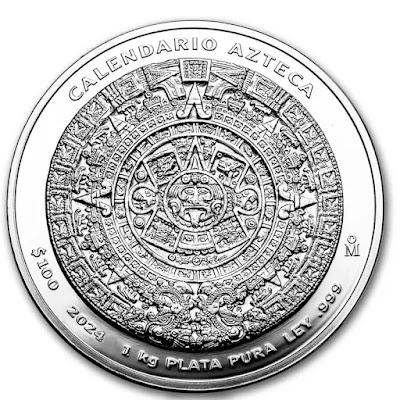



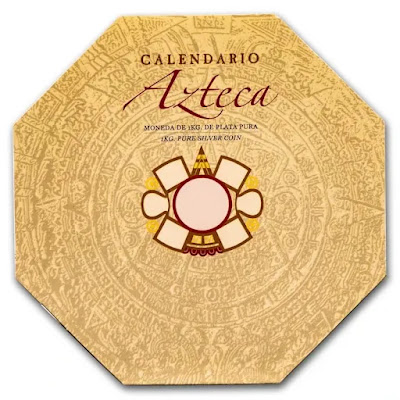






















Rajan Trikha has commented:
ReplyDelete"Wonderful post 👍"
Thank you Trikha sahab for visiting this post.
Delete